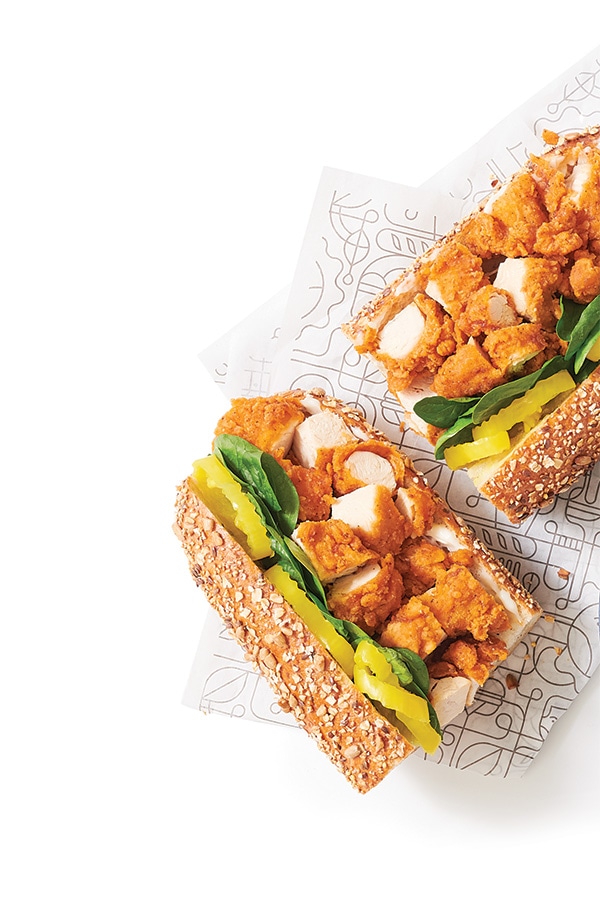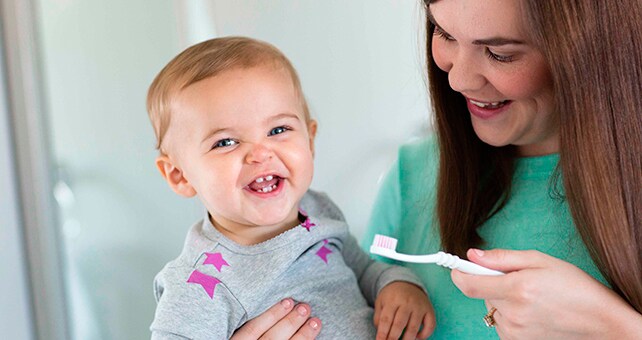Treat those wee pearly whites right. Teaching your child early about proper dental hygiene instills a healthy habit that lasts a lifetime.
Source: "Dental Health & Hygiene for Young Children." HealthyChildren.org. October 14, 2015.
Baby Brush
Regular cleanings should start as soon as that first little whitecap appears, or even earlier, to get your baby used to it. Wipe daily (perhaps at bath time) with a damp cloth or super soft-bristle brush designed for infants.
Sources:
"Baby Tooth Care." American Academy of Pediatrics. 2017.
"FAQ." American Academy of Pediatric Dentistry. 2017.
"Keeping Your Child's Teeth Healthy." KidsHealth. May 2015.
"Tips for Parents." American Academy of Pediatrics. 2017.
Toothpaste Rules
Brush your baby's teeth with a smear of fluoridated toothpaste the size of a grain of rice, then a pea-size amount once your child turns three. Explain that it's very important not to swallow, no matter how yummy the paste tastes.
Sources:
"Brushing Up on Oral Health: Never Too Early to Start." HealthyChildren.org. October 3, 2014.
"Keeping Your Child's Teeth Healthy." KidsHealth. May 2015.
"Tips for Parents." American Academy of Pediatrics. 2017.
Choose Wisely
Select a child's toothbrush with soft bristles, a small head, and an easy-to-grip handle. And if one with a favorite color or character makes brushing more fun, go for it!
Source: "Let the Brushing Games Begin." HealthyChildren.org. November 21, 2015.
Twice Is Nice
Think "two and two": Brush two times a day for two straight minutes. Use a timer or a short song to make sure your child stays with it long enough.
Sources:
"Healthy Smiles: A Family Guide." American Academy of Pediatric Dentistry. 2009.
"Take two minutes to brush." American Dental Association. August 16, 2012.
"Tips for Parents." American Academy of Pediatrics. 2017.
"Keep Kids' Mouths Healthy." 2min2x.org. 2017.
"Toothbrushing Tips for Young Children." HealthyChildren.org. November 21, 2015.
Little Help?
You should do the brushing until your child turns two. Even then, help or closely supervise until at least age six, or when rinsing and spitting excess paste is a breeze.
Sources:
"Keeping Your Child's Teeth Healthy." KidsHealth. May 2015.
"Healthy Smiles: A Family Guide." American Academy of Pediatric Dentistry. 2009.
"Tips for Parents." American Academy of Pediatrics. 2017.
Super Power
Electric toothbrushes designed for kids can help them do a better job cleaning their teeth. The appliances are especially great for transitioning from parent brushing to doing the job solo.
Source: "Healthy Smiles: A Family Guide." American Academy of Pediatric Dentistry. 2009.
When to Start Flossing
Flossing should begin when two teeth touch—typically around two, or two-and-a-half years old. Heads-up: You probably have to help for several years to come, though pre-threaded flossers can speed up independence.
Sources:
"A Pediatric Guide to Children's Oral Health." American Academy of Pediatrics. 2010.
"Tips for Parents." American Academy of Pediatrics. 2017.
Freshen Up
Replace your child's toothbrush every three to four months at least—more often if your child has been sick, or if the brush's bristles are worn or frayed.
Sources:
"The Use and Handling of Toothbrushes." Centers for Disease Control and Prevention. July 10, 2013.
"Toothbrush Care: Cleaning, Storing and Replacement." American Dental Association. November 2011.
"Keep Kids' Mouths Healthy." 2min2x.org. 2017.
Expert Advice
Schedule the first dental visit anytime between when that first tooth makes its appearance and your child's first birthday. That way, the dentist can make sure everything's coming in properly and help your little one develop healthy dental habits early.
Sources:
"FAQ." American Academy of Pediatric Dentistry. 2017.
"Keeping Your Child's Teeth Healthy." KidsHealth. May 2015.
"Healthy Smiles: A Family Guide." American Academy of Pediatric Dentistry. 2009.
Toothbrushing is only part of your toddler's good bedtime routine. Get tips and tricks for establishing a relaxing nighttime wind-down routine.
This content is provided for general information purposes only. It is not intended to be a substitute for medical advice or a guarantee of prevention, improvement, or treatment of specific conditions. Always consult with your healthcare provider about your specific medical questions or concerns.


